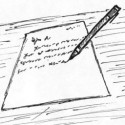Cursive Writing: A Dying Art in School

With the modern popularity of computers, tablets, and smartphones changing the way people communicate, there is also the consequence of fewer people knowing how to use cursive writing. On the larger scale, this is partly because many people no longer regularly write by hand, and partly because in many places this skill is no longer taught in elementary school. While it is somewhat understandable that the focus is on typing and computers, given that more and more communication tasks are becoming digital, there are nevertheless some downsides to the loss of cursive writing.
Learning and using cursive writing has many benefits. Typing does not offer much feedback to the brain, so there is a better connection in the brain between the information and the physical act of handwriting, because handwriting engages circuits in the brain that typing with a keyboard simply does not. Cursive handwriting is a complex skill that affects and engages cognitive development, visual, motor and memory circuits, and hand-eye coordination. With the decline of learning cursive at a young age, there can potentially be a detrimental effect on people, such as taking longer to perfect these fine motor skills. There is also a strong scientific and psychological following that the use of handwriting affects how deeply and expressively people are able to understand and communicate their thoughts and ideas.
There are of course many practical considerations to learning cursive writing skills. One of these is to develop your own unique written signature for signing documents. While there is an increased trend toward digital signatures and biometrics such as fingerprint scanning, the unique identifier of a written signature is still valuable.
As well, there are still many times you will encounter situations in which using a computer, keyboard, or other electronic device is simply not an option; as a student, most of these will come in the form of in-class midterms and final exams, which are typically still handwritten. Especially in writing-heavy courses, time is of the essence when you have to complete essay answers and other written work in only an hour or two. Writing in cursive is much, much faster than printing, and can make the difference between being able to get all your answers down, or running out of time with questions and discussion points still unfinished.
If you never learned cursive, it’s not too late! All you need is a guide of the letterforms, and then it’s just practice, practice, practice by forcing yourself to write in cursive all the time. Before long, it will be as natural as breathing! And if seeing fancy handwriting seems intimidating, just remember that no one expects perfect letters, loops and joins all the time; rather, learning cursive will allow you to develop a fast, easy, and personal writing style all your own!
SOURCES:
https://en.wikipedia.org/wiki/Cursive
http://www.pbs.org/newshour/updates/long-held-tradition-cursive-handwriting-slowly-dying-america/





Leave a comment!